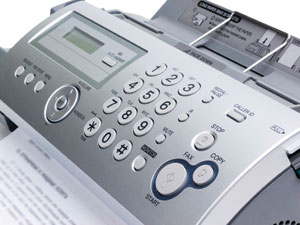Not Only Won’t It Die, The Number of Faxed Pages Is also Growing in Some Forms
By Steve Adams
Let’s be honest. By now, you’d think that faxing would be dead, a victim of all those killer apps (such as email, texting and IM) that came after it. You would expect that the only place you’d see a fax or hear the screech of a fax transmission would be in a movie from the ‘80s, or at an exhibit at the Smithsonian. But you would be wrong.  Like another icon of the ‘80s, the Terminator, faxing is a technology that just won’t die. In fact, not only won’t it die, the number of faxed pages is growing in some forms (such as those sent using Internet fax technology). All of which probably beg the question, “Why?” As in why on earth would you fax a document when you could email it?
Like another icon of the ‘80s, the Terminator, faxing is a technology that just won’t die. In fact, not only won’t it die, the number of faxed pages is growing in some forms (such as those sent using Internet fax technology). All of which probably beg the question, “Why?” As in why on earth would you fax a document when you could email it?
Why Fax?
Actually there are a number of reasons to fax —some of them practical, some of them legal, and some of them the result of industries that see no reason to “fix” a system that “ain’t broke.”
Take the healthcare industry. The Health Information Portability and Accountability Act (HIPAA) guarantees patients’ rights to privacy and confidentiality regarding their medical records. Because it is relatively easy for an unscrupulous person to intercept email, HIPAA prohibits medical records from being transmitted via email. That means when doctors need to exchange patient records quickly over a long distance, faxing becomes the method of choice. mFax is a company that offers electronic faxing that is specifically built to comply with HIPPAA guidelines taking the guesswork out as to whether you’re following all the rules!
The construction industry is another that relies heavily on faxing, but for a different reason. There is no law prohibiting a plumbing contractor from ordering a pallet of toilets from a wholesaler. It’s more a matter of convention. The industry’s electronic ordering procedures were built around faxing 20-some years ago, and to date, it hasn’t found a compelling reason to change. It’s likely that handwritten notes and quick sketches of what’s needed have a lot to do with the reluctance to change as well. And with bids on jobs becoming even more competitive thanks to the continued economic woes, the speed, convenience and flexibility of faxing have significantly increased its use in the last few years.
In the real estate, mortgage banking and insurance industries, the need for signatures on legal documents is the driving force. While the eSign Act of 2000 provided for the use of electronic signatures, that use still requires consent for their use by both parties. In effect, it creates an extra step in the process. The fastest and easiest method of approving a contract or a transaction remains applying the end of a pen to a piece of paper. It’s also the method with which most people (and companies) are comfortable.
Other industries abound with similar sets of needs and conventions, which make it obvious that faxing will be alive, well and healthy for the foreseeable future. But that doesn’t mean it remains unchanged from the days the fax machine first started taking up space in offices and homes across North America.
Faxing Is Changing
In today’s mobile world, using a stationary, heavy machine tied to an electrical outlet and a specific physical phone line just doesn’t work very well. Instead, more and more businesses, from small companies to large enterprises, are making the switch to an Internet fax service. It makes sense. An Internet fax service provides the security and ability to transmit signatures of a fax with the ease and convenience of sending an email. If you have signed up with an Internet fax service, all you need to send and receive faxes is an email account and an Internet connection. It can be a wired connection, a Wi-Fi connection, or even your mobile phone’s data plan.
An Internet fax service is also a lot less expensive than a fax machine. First off, you eliminate the machine itself — and the hassle of having to dispose of it and get another one when the machine exceeds its shelf life. You don’t need a second phone line, which can save $25 to $50 per month or more alone, or special toner just for the machine.
You’ll also save on paper. The only faxes you print are the ones you choose to, since all faxes are sent and received electronically. Electronic faxes are a lot easier to store and carry with you than paper, too. And, you can easily create a backup of all your electronic faxes just in case the originals get lost. Customers and business partners in today’s world also respond positively to organizations that are going greener by reducing paper and power consumption. When you get right down to it, it’s amazing there are any fax machines left.
Yes, despite what you may have heard, faxing is still alive and well. And it will continue to be an important factor in many organizations for a long time to come. What’s changing is how faxes are being sent and received. Skip the machine, and move instead to an Internet fax service. It’s how faxing gets done in this millennium. HBM
Find a Home-Based Business to Start-Up >>> Hundreds of Business Listings.
















































